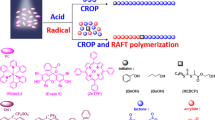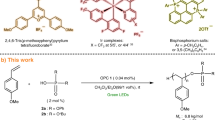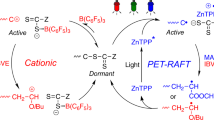Abstract
Living polymerizations involve the creation of polymer chains without significant irreversible chain transfer or chain termination1. Such processes are widely used to access well-defined macromolecular materials with controlled architectures, such as block and star polymers. Although this concept was first realized for anionic polymerizations in the 1950s2, many key recent advances have been made, most notably in the area of radical polymerization3,4,5,6. Here, we report a living photopolymerization that involves photoexcited monomers. Exposure of metal-containing ferrocenophane monomers to Pyrex-filtered light from a mercury lamp (λ>310 nm) or to bright sunlight in the presence of an anionic initiator leads to living polymerizations, in which the conversion and molecular weight of the resulting polymer can be controlled by the irradiation time. Photoirradiation selectively weakens the iron–cyclopentadienyl bond in the monomer, allowing the use of moderately basic and highly functional-group-tolerant initiators. The polymerization proceeds through attack of the initiator and propagating anion on the iron atom of the photoexcited monomer and, remarkably, the polymerization rate decreases with increasing temperature. Block copolymer formation is possible when the light source is alternately switched on and off in between sequential addition of different monomers, providing unprecedented, photocontrolled access to new types of functional polymers.
This is a preview of subscription content, access via your institution
Access options
Subscribe to this journal
Receive 12 print issues and online access
$259.00 per year
only $21.58 per issue
Buy this article
- Purchase on Springer Link
- Instant access to full article PDF
Prices may be subject to local taxes which are calculated during checkout




Similar content being viewed by others
References
Odian, G. G. Principles of Polymerization (Wiley, New York, 1981).
Szwarc, M. ‘Living’ polymers. Nature 178, 1168–1169 (1956).
Patten, T. E., Xia, J., Abernathy, T. & Matyjaszewski, K. Polymers with very low polydispersities from atom transfer radical polymerization. Science 272, 866–868 (1996).
Georges, M. K., Veregin, R. P. N., Kazmaier, P. M. & Hamer, G. K. Narrow molecular weight resins by a free-radical polymerization process. Macromolecules 26, 2987–2988 (1993).
Kato, M., Kamigaito, M., Sawamoto, M. & Higashimura, T. Polymerization of methyl methacrylate with the carbon tetrachloride/dichlorotris-(triphenylphosphine)ruthenium(II)/methylaluminum bis(2,6-di-tert-butylphenoxide) initiating system: possibility of living radical polymerization. Macromolecules 28, 1721–1723 (1995).
Akatsuka, M., Aida, T. & Inoue, S. High-speed “immortal” polymerization of epoxides initiated with aluminum porphyrin. Acceleration of propagation and chain-transfer reactions by a Lewis acid. Macromolecules 27, 2820–2825 (1994).
Manners, I. Poly(ferrocenylsilanes): novel organometallic plastics. Chem. Commun. 857–865 (1999).
Tanabe, M. & Manners, I. Photolytic living anionic ring-opening polymerization (ROP) of silicon-bridged [1]ferrocenophanes via an iron-cyclopentadienyl bond cleavage mechanism. J. Am. Chem. Soc. 126, 11434–11435 (2004).
Mizuta, T., Imamura, Y. & Miyoshi, K. Ring-opening reaction of phosphorus-bridged [1]ferrocenophane via ring slippage fromη5- toη1-Cp. J. Am. Chem. Soc. 125, 2068–2069 (2003).
Berenbaum, A. et al. Synthesis, electronic structure, and novel reactivity of strained, boron-bridged [1]ferrocenophanes. J. Am. Chem. Soc. 122, 5765–5774 (2000).
Yamaguchi, Y. & Kutal, C. Efficient photodissociation of anions from benzoyl-functionalized ferrocene complexes. Inorg. Chem. 38, 4861–4867 (1999).
Ding, W. et al. Characterization of the low-energy electronic excited states of benzoyl-substituted ferrocenes. Inorg. Chem. 42, 1532–1537 (2003).
Rulkens, R. et al. Highly strained, ring-tilted [1]ferrocenophanes containing group 16 elements in the bridge: synthesis, structures, and ring-opening oligomerization and polymerization of [1]thia- and [1]selenaferrocenophanes. J. Am. Chem. Soc. 119, 10976–10986 (1997).
Barlow, S. et al. Electronic structure of strained silicon- and sulfur-bridged [1]ferrocenophanes and an analogous dicarbon-bridged [2]ferrocenophane: an investigation by photoelectron spectroscopy and density-functional theory. Organometallics 17, 2113–2120 (1998).
Harrigan, R. W., Hammond, G. S. & Gray, H. B. Photochemistry of titanocene(IV) derivatives. J. Organomet. Chem. 81, 79–85 (1974).
Penczek, S., Kubisa, P. & Szymanski, R. On the diagnostic criteria of the livingness of polymerizations. Makromol. Chem. Rapid Commun. 12, 77–80 (1991).
Manners, I. Putting metals into polymers. Science 294, 1664–1666 (2001).
Bender, J. L. et al. Site-isolated luminescent europium complexes with polyester macroligands: metal-centered heteroarm stars and nanoscale assemblies with labile block junctions. J. Am. Chem. Soc. 124, 8526–8527 (2002).
Eitouni, H. B. & Balsara, N. P. Effect of chemical oxidation on the self-assembly of organometallic block copolymers. J. Am. Chem. Soc. 126, 7446–7447 (2004).
Temple, K. et al. Spontaneous vertical ordering and pyrolytic formation of nanoscopic ceramic patterns from poly(styrene-b-ferrocenylsilane) (PS-PFS). Adv. Mater. 15, 297–300 (2003).
Lastella, S. et al. Density control of single-walled carbon nanotubes using patterned iron nanoparticle catalysts derived from phase-separated thin films of a polyferrocene block copolymer. J. Mater. Chem. 14, 1791–1794 (2004).
Hinderling, C. et al. Organometallic block copolymers as catalyst precursors for templated carbon nanotube growth. Adv. Mater. 16, 876–879 (2004).
Kloninger, C. & Rehahn, M. 1,1-dimethylsilacyclobutane-mediated living anionic block copolymerization of [1]dimethylsilaferrocenophane and methyl methacrylate. Macromolecules 37, 1720–1727 (2004).
Lohmeijer, B. G. G. & Schubert, U. S. Supramolecular engineering with macromolecules: an alternative concept for block copolymers. Angew. Chem. Int. Edn 41, 3825–3829 (2002).
Hou, S., Man, K. Y. K. & Chan, W. K. Nanosized micelles formed by the self-assembly of amphiphilic block copolymers with luminescent rhenium complexes. Langmuir 19, 2485–2490 (2003).
Massey, J. A. et al. Fabrication of oriented nanoscopic ceramic lines from cylindrical micelles of an organometallic polyferrocene block copolymer. J. Am. Chem. Soc. 123, 3147–3148 (2001).
Mîinea, L. A., Sessions, L. B., Ericson, K. D., Glueck, D. S. & Grubbs, R. B. Phenylethynylstyrene-cobalt carbonyl block copolymer composites. Macromolecules 37, 8967–8972 (2004).
Herberhold, M. Distorted sandwich compounds: [1]ferrocenophanes and [2]ruthenocenophanes. Angew. Chem. Int. Edn 34, 1837–1839 (1995).
Braunschweig, H. et al. Synthesis and structure of [Cr{(η6-C6H5)2B{NtBu(SiMe3)}} ] and [Cr{(η6-C6H5)2(BNMe2)2} ], the first boron-bridged metalloarenophanes. Organometallics 23, 1968–1970 (2004).
Berenbaum, A. & Manners, I. Transition metal-catalyzed ring-opening polymerization (ROP) of strained, silicon-bridged bis(benzene)chromium complexes. Dalton Trans. 2057–2058 (2004).
Vogel, U., Lough, A. J. & Manners, I. Isolation of [1]ruthenocenophanes: synthesis of polyruthenocenylstannanes by ring-opening polymerization. Angew. Chem. Int. Edn 43, 3321–3325 (2004).
Tamm, M. et al. Ansa-cycloheptatrienyl-cyclopentadienyl complexes. Angew. Chem. Int. Edn 43, 5530–5534 (2004).
Schachner, J. A., Lund, C. L., Quail, J. W. & Müller, J. Synthesis and characterization of the first aluminum-bridged [1]ferrocenophane. Organometallics 24, 785–787 (2005).
Elschenbroich, C., Paganelli, F., Nowotny, M., Neumüller, B. & Burghaus, O. Trovacene chemistry. 10. the [cyclic] [1]- and [2]silatrovacenophanes (η7-C7H6)V(η5-C5H4SiR2) and (η7-C7H6)V(η5-C5H4SiR2SiR2) (R=Me, Ph): synthesis, structure, and ring opening. Z. Anorg. Allg. Chem. 630, 1599–1606 (2004).
Acknowledgements
N. Coombs and M. Mamak are acknowledged for their assistance with electron microscopy imaging. X. Lou is acknowledged for his help with the GPC experiments. G.W.M.V. thanks the Deutsche Forschungsgemeinschaft (DFG) for a postdoctoral research stipend. W.Y.C thanks the Natural Sciences and Engineering Research Council (NSERC) of Canada for a postgraduate scholarship. I.M. thanks the European Union for a Marie-Curie Chair and the Royal Society for a Wolfson Research Merit Award.
Author information
Authors and Affiliations
Corresponding author
Ethics declarations
Competing interests
The authors declare no competing financial interests.
Supplementary information
Supplementary Information
Supplementary table 1, figures 1 and 2, materials and methods (PDF 305 kb)
Rights and permissions
About this article
Cite this article
Tanabe, M., Vandermeulen, G., Chan, W. et al. Photocontrolled living polymerizations. Nature Mater 5, 467–470 (2006). https://doi.org/10.1038/nmat1649
Received:
Accepted:
Published:
Issue Date:
DOI: https://doi.org/10.1038/nmat1649
This article is cited by
-
Design and Functions of Macromolecular Electron-Reservoir Complexes and Devices
Journal of Inorganic and Organometallic Polymers and Materials (2020)
-
Synthesis of hyperbranched polyferrocenylsilanes as preceramic polymers for Fe/Si/C ceramic microspheres with porous structures
Journal of Materials Science (2015)



